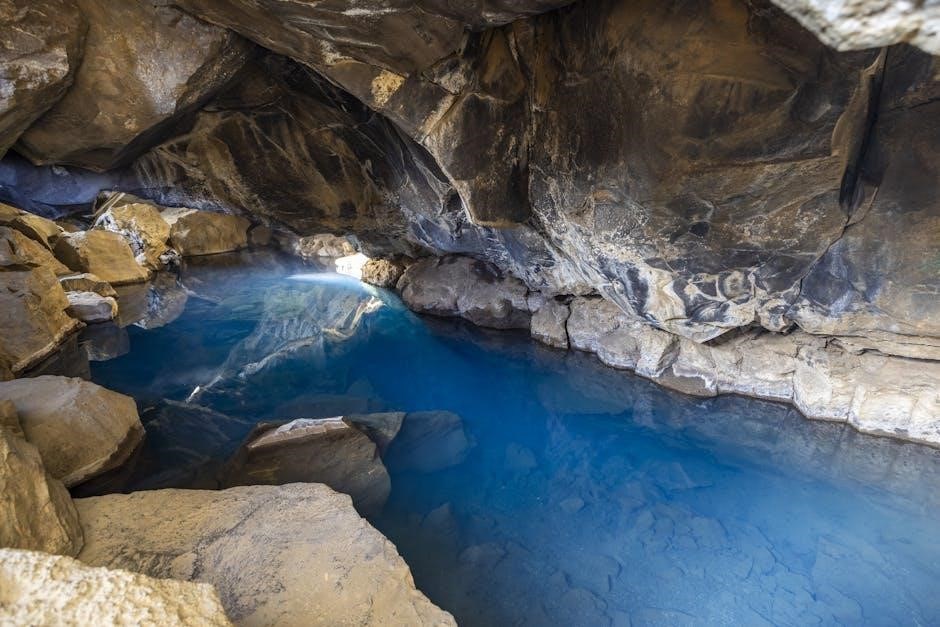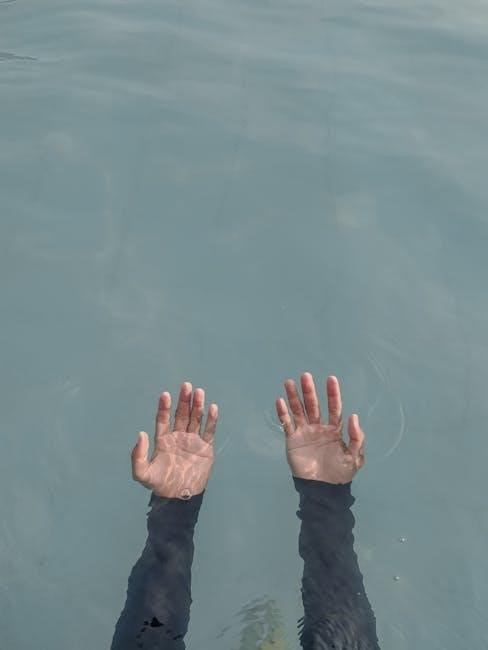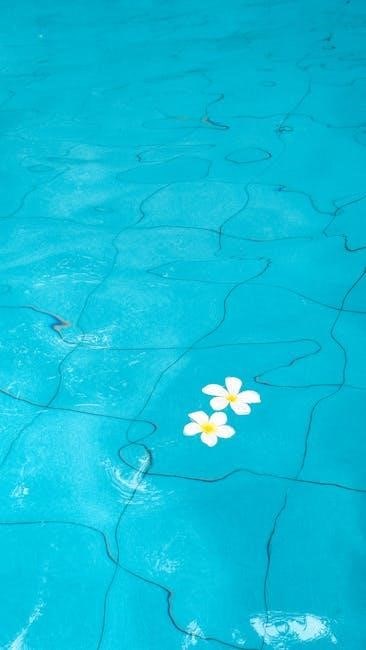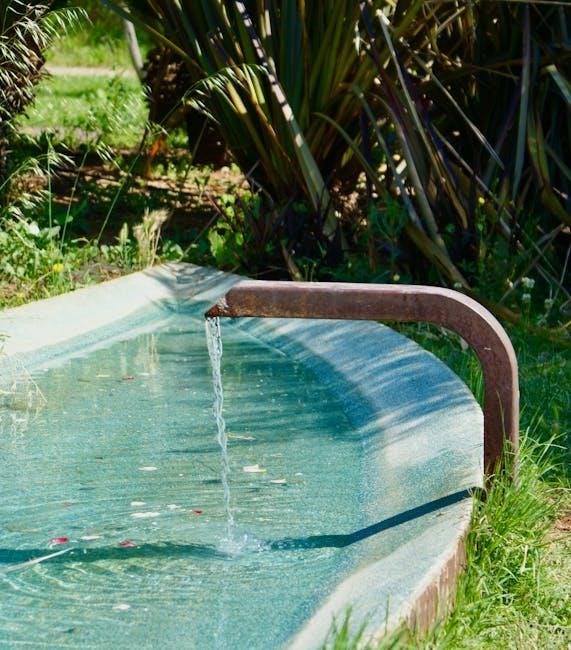Safety Precautions and Guidelines
Always install safety barriers to prevent unauthorized access, especially for children and pets. Adult supervision is required during assembly and disassembly. Never dive or jump into the pool, as it can cause serious injury. Follow the user manual instructions carefully to ensure safe operation and longevity of the pool.
- Install a safety fence or gate around the pool area.
- Ensure no running or horseplay near the pool.
- Keep the pool area clean and clear of obstacles.

Regularly inspect the pool and its components for damage or wear.
1.1 General Safety Tips for Intex Pool Usage
Safety is crucial when using an Intex pool. Never dive, jump, or slide into the pool, as it can lead to severe injuries. Ensure adult supervision at all times, especially for children. Install a safety barrier to prevent unauthorized access. Follow the user manual instructions carefully and inspect the pool area regularly for hazards. Keep the surrounding clean and clear of obstacles to avoid accidents. Always prioritize caution to ensure a safe and enjoyable experience.
- No diving or jumping into the pool.
- Adults must supervise children at all times.
- Install safety barriers to restrict access.
1.2 Installing Safety Barriers
Installing safety barriers is essential to prevent accidents and unauthorized access to the pool. Use a sturdy fence or gate that surrounds the pool area, ensuring it is at least 4 feet tall. The barrier should be self-closing and self-latching to prevent children or pets from entering unsupervised. Regularly inspect the barrier for damage or wear. Ensure the gate is locked when the pool is not in use for added safety.
- Use a fence or gate around the pool perimeter.
- Ensure the barrier is at least 4 feet tall.
- Install self-closing and self-latching gates.
1.3 Age and Supervision Requirements
Only adults should assemble and disassemble the pool. Children must be supervised at all times when near the pool. Never allow unsupervised access to the pool area. Teach children basic pool safety rules, such as no diving or jumping. Ensure all users understand the risks of improper pool use. Adult supervision is crucial to prevent accidents and ensure safe enjoyment of the pool.
- Adults only for assembly and disassembly.
- Supervise children near the pool at all times.
- Teach children pool safety guidelines.

Choosing the Right Intex Pool Model
Selecting the right Intex pool model depends on size, shape, and features. Consider Ultra Frame or Prism Frame pools for durability and ease of setup. Choose sizes like 18x9x52 or 32x16x52 based on space and user needs.
2.1 Factors to Consider When Selecting a Pool
When choosing an Intex pool, consider size, shape, and intended use. Measure your available space and select models like 18x9x52 or 32x16x52. Think about features such as frame type (Ultra Frame or Prism Frame) and depth. Budget and durability are also key factors. Ensure the pool suits your family’s needs and preferences for recreation or relaxation.
- Space availability and pool dimensions.
- Number of users and intended activities.
- Pool depth and safety features.
- Setup and maintenance requirements.
2.2 Popular Intex Pool Models and Their Features
Intex offers various pool models, each designed for different needs. The Ultra Frame Rectangular Pool is durable and easy to assemble. The Prism Frame Rectangular Pool features a sleek design and sturdy construction. The Ultra XTR Rectangular Pool includes advanced features like a robust frame and superior filtration. Each model varies in size, depth, and accessories, ensuring there’s an option for every user.
- Ultra Frame: Durable and easy to set up.
- Prism Frame: Sleek design with strong build.
- Ultra XTR: Advanced features and larger sizes.
Site Preparation and Installation
Choose a flat, stable area for your pool, ensuring proper drainage. Clear the site of debris and level the ground thoroughly. Use a ground cloth to protect the pool bottom from sharp objects.
- Select a location with good drainage.
- Ensure the area is free from obstacles.
- Level the ground for even installation.
3.1 Selecting the Ideal Location for Your Pool
Choose a flat, stable area for your Intex pool, ensuring proper drainage and sunlight exposure. Avoid low-lying areas where water may collect. Keep the pool away from overhead obstructions like trees or power lines. Ensure the location is accessible for installation and maintenance. A level surface is crucial for proper pool functioning and safety.
- Select a flat, even surface.
- Ensure good drainage to prevent water pooling.
- Avoid areas with overhead obstructions.
3.2 Leveling the Ground for Proper Installation
Ensure the ground is level and firm before installing your Intex pool. Use a shovel to remove dirt from low areas and fill in high spots. Sand or fine gravel can help achieve a smooth surface. Check the area with a spirit level to confirm evenness. Proper leveling prevents pool damage and ensures safe operation.
- Clear debris and rocks from the area.
- Use a spirit level to verify evenness.
- Make adjustments with sand or soil as needed.
3.3 Clearing the Area of Debris
Clear the installation site of debris, rocks, and vegetation to ensure a smooth setup. Remove any sharp objects that could puncture the pool liner. Use a rake to even out the ground and eliminate twigs or leaves. A clean area prevents damage and ensures proper pool installation.
- Remove rocks, sticks, and sharp objects.
- Rake the ground to eliminate debris.
- Inspect the area for any remaining obstructions.
Pool Assembly and Setup
Assemble the pool in a designated 12×24-foot area, ensuring no tools are needed. Follow the manual for a safe and proper setup process.

4.1 Unboxing and Inventory of Parts
Begin by carefully unboxing and inventorying all components to ensure completeness. Check for any damage or missing items. Essential parts include the pool frame, liner, pump, and connectors. Match each part with the manual’s inventory list. Organize components to avoid confusion during assembly. Verify that all hardware and accessories are included before proceeding. This step ensures a smooth and efficient setup process.
4.2 Step-by-Step Assembly Instructions
Start by connecting the pool frame parts securely, ensuring all joints are tight. Attach the liner carefully to avoid tears. Next, install the pump and filter system according to the manual. Inflate the top ring firmly and connect it to the pool frame. Follow the sequence outlined in the instructions to avoid misalignment. No tools are required, as the pool is designed for easy assembly. Double-check all connections before filling with water.
4.3 Connecting the Pump and Filter System
Attach the hoses to the pump and filter, ensuring all connections are secure. Follow the manual for proper alignment and tightening. Connect the pump to the pool’s inlet and outlet ports. Turn on the pump to test water flow and check for leaks. Ensure the filter is correctly installed and cycles water efficiently. No tools are required for this step, as the system is designed for easy setup.
Filtration System Installation
Install the filter pump according to the manual, ensuring all connections are secure. Connect hoses to the pool and filter, then test for leaks. No tools required.
5.1 Understanding the Filtration System Components
The Intex pool filtration system includes a pump, filter, and hoses. The pump circulates water, pushing it through the filter to remove dirt and debris. The filter, typically a cartridge or sand type, cleans the water before it returns to the pool. Proper connection of hoses ensures water flows smoothly through the system. Understanding these components is essential for effective pool maintenance and water clarity. Regular inspection ensures optimal performance and safety.
- Pump: Powers water circulation.
- Filter: Removes impurities.
- Hoses: Connect components securely.
Ensure all parts are correctly aligned for proper flow and filtration efficiency.
5.2 Proper Installation of the Filter Pump

Install the filter pump on a level, stable surface near the pool. Connect the hoses securely to the pool inlet and outlet. Ensure all connections are tight to prevent leaks. Plug in the pump and test its operation. Follow the manual for specific instructions to avoid damage or malfunction. Proper installation ensures efficient water circulation and filtration, maintaining clean and safe pool water. Always refer to the user manual for detailed guidance.
- Place pump on a flat surface.
- Secure hoses tightly to prevent leaks.
- Test operation before full use.
Regularly check connections for tightness and integrity.
5.3 Maintenance Tips for the Filtration System
Regularly clean the filter cartridge by rinsing with a garden hose. Check for debris in the pump basket and remove it promptly. Replace the filter cartridge as recommended by the manufacturer. Ensure proper water flow by maintaining balanced water chemistry. Lubricate O-rings and connections to prevent leaks. Schedule periodic inspections of the filtration system to ensure optimal performance and longevity.
- Clean the filter cartridge weekly.
- Inspect the pump basket daily.
- Replace filters as needed.
Proper maintenance ensures clean and safe pool water year-round.

Pool Maintenance and Upkeep
Regularly skim the surface and clean the pool floor. Test water chemistry weekly and adjust as needed. Perform scheduled maintenance tasks to ensure optimal pool conditions.
- Daily skimming prevents debris buildup.
- Weekly water testing maintains safety.
- Follow the manual for guidance.
6.1 Daily Cleaning and Skimming
Daily cleaning is essential for maintaining a clean and safe pool environment. Use a skimmer net to remove floating debris and clean the pool floor regularly. Consistency prevents algae growth and keeps water clear. Brush the pool walls and floor to remove dirt and contaminants. Empty the skimmer basket and pump basket daily to ensure proper water circulation. Regular cleaning prevents debris buildup and maintains optimal water quality for swimmers.
- Skim the surface daily with a net.
- Brush the pool walls and floor.
- Empty baskets and check the pump.
6.2 Regular Testing of Water Chemistry
Regular testing of water chemistry is crucial for maintaining a safe and clean pool environment. Use test strips or kits to monitor pH, chlorine, and alkalinity levels. Proper balance prevents eye irritation and algae growth. Adjust chemicals as needed to maintain recommended levels. Frequent testing ensures optimal water quality and swimmer comfort. Consistency helps prevent costly corrections and keeps the pool system functioning efficiently.
- Test water chemistry at least twice a week.
- Adjust pH and chlorine levels as needed.
- Monitor alkalinity to stabilize pH levels.
6.3 Scheduled Maintenance Tasks
Regular maintenance ensures your Intex pool remains safe and functional. Schedule tasks like cleaning the filter, inspecting the pool liner, and checking the pump system. These steps prevent damage and extend the pool’s lifespan. Consistent upkeep also enhances swimming enjoyment and safety.
- Clean the filter weekly to maintain proper water circulation.
- Inspect the pool liner monthly for signs of wear or leaks.
- Check the pump system regularly for optimal performance.
- Prepare for winter by draining and storing the pool properly.
- Keep the surrounding area clean to prevent debris accumulation.
Water Treatment and Chemical Balance
Regular water testing ensures safe and clean swimming conditions. Maintain proper pH and chlorine levels to prevent algae growth and eye irritation. Sanitize the pool water consistently for optimal hygiene and clarity.
- Use a test kit to monitor water chemistry regularly.
- Adjust chemical levels as recommended in the manual.
- Sanitize the pool water to maintain a healthy environment.
7.1 Testing Water Quality
Regular water testing is essential for maintaining a safe and clean swimming environment. Use a test kit to check pH, chlorine, and alkalinity levels. Proper pH levels should range between 7.2 and 7.8, while chlorine levels should be between 1 and 3 ppm. Imbalanced levels can cause eye irritation or algae growth. Test the water at least twice a week and after heavy use. Adjust chemicals as needed to ensure optimal water quality and swimmer safety.
- Test pH and chlorine levels regularly.
- Adjust chemicals to maintain balanced levels.
- Ensure safe and clean swimming conditions.
7.2 Balancing pH and Chlorine Levels
Properly balancing pH and chlorine levels is crucial for swimmer safety and pool longevity. The ideal pH range is 7.2–7.8, while chlorine levels should be 1–3 ppm. Imbalanced levels can cause eye irritation, skin discomfort, or algae growth. Use test strips or kits to monitor levels regularly and adjust chemicals as needed. Always follow the manufacturer’s instructions for adding chemicals to ensure a safe and healthy swimming environment.
- Test pH and chlorine levels frequently.
- Adjust chemicals to maintain optimal ranges.
- Prevent eye irritation and algae growth.
7.3 Sanitizing the Pool Water
Regular sanitizing is essential to maintain clean and safe pool water. Use chlorine tablets or granules to disinfect the water, ensuring levels remain between 1–3 ppm. Shock treatments can help eliminate contaminants and odors. Always test the water after adding chemicals and wait the recommended time before allowing swimmers to enter. Proper sanitization prevents bacterial growth and keeps the pool water clear and healthy for use.
- Test chlorine levels before and after treatment.
- Apply shock treatments as needed to remove impurities.
- Wait the recommended time before swimming.

Winterization and Storage
Prepare your Intex pool for winter by draining it completely and storing it in a dry, protected area. Clean and dry all components thoroughly before storage to prevent damage and mold growth. Use a pool cover to shield it from debris during the off-season. Proper storage ensures your pool remains in good condition for the next use.
- Drain the pool and clean all parts.
- Store in a dry, sheltered location.
- Use a cover to protect from debris.
8.1 Preparing the Pool for Winter
Drain the pool completely and clean all surfaces thoroughly. Remove and dry all accessories, such as ladders and filters. Apply a pool cover to protect from debris and weather. Store the pool in a dry, sheltered area to prevent damage. Ensure all components are clean and dry before storage to avoid mold and mildew growth during the off-season.

- Drain the pool fully to prevent freezing damage.
- Clean and dry all pool parts and accessories.
- Use a high-quality pool cover for protection.
- Store in a dry, sheltered location.
8.2 Draining and Storing the Pool
Completely drain the pool using a submersible pump or the built-in drainage system. Once empty, disassemble the pool frame and components according to the manual. Store all parts in a dry, clean area, protected from weather and pests. Ensure all items are securely packed to prevent damage during storage.
- Use a submersible pump for efficient draining.
- Disassemble the pool frame carefully.
- Store components in a dry, clean space.
- Protect from weather and pests.
8.3 Protecting the Pool During Off-Season
Protect the pool during the off-season by covering it with a high-quality pool cover to prevent debris and damage. Store the pool components in a dry, clean area, away from direct sunlight and pests. Regularly inspect stored items for signs of wear or damage. Use protective covers for pumps and filters to maintain their condition.
- Cover the pool to shield from weather and debris.
- Store components in a dry, pest-free environment.
- Inspect stored items for damage or wear.
- Use protective covers for pumps and filters.

Troubleshooting Common Issues
Identify and address leaks promptly to prevent water loss. Check and clean the filter regularly to ensure proper water circulation. Inspect for algae growth and treat the water if necessary.
- Inspect the pool and equipment for visible damage.
- Refer to the user manual for specific troubleshooting guides.
- Contact customer support for unresolved issues.
9.1 Identifying and Fixing Leaks
Inspect the pool and equipment for visible cracks or damage. Check connections and seals for tightness. Use a patch kit to repair small punctures or tears. Apply adhesive carefully following the manufacturer’s instructions. For larger leaks, consult the user manual or contact customer support for assistance. Regular inspections can help prevent further damage and ensure the pool remains safe and functional.
- Examine the pool floor, walls, and seams for water seepage.
- Test suspect areas with a mixture of water and dish soap to locate leaks.
- Replace damaged parts if patches are ineffective.
9.2 Resolving Pump and Filter Problems
Check for blockages in the pump or filter by cleaning or replacing the cartridge. Ensure all connections are secure and properly aligned. If the pump doesn’t start, verify power supply and reset if necessary. Refer to the user manual for specific troubleshooting steps. For persistent issues, contact Intex customer support or replace faulty components.
- Inspect the filter for dirt and clean it regularly.
- Ensure the pump is primed correctly before operation.
- Replace worn or damaged seals to prevent leaks.
9.3 Addressing Algae Growth
Regularly test and balance water chemistry to prevent algae growth. Maintain proper chlorine and pH levels, and sanitize the pool water as needed. Clean the pool floor and walls frequently to remove debris. Use an algaecide if algae appear, following the product’s instructions. Ensure the filtration system operates efficiently to keep water clean and clear.
- Shock the pool if algae growth persists.
- Run the filter continuously during peak sunlight hours.
- Brush pool surfaces weekly to remove algae buildup.

Disassembly and Storage
Drain the pool completely and clean all components before storage. Store the pool and accessories in a dry, protected area to prevent damage. Adult supervision is required during disassembly.
- Ensure all parts are dry to avoid mold and mildew.
- Store components in their original packaging if possible.
10.1 Safe Disassembly of the Pool
Drain the pool completely and clean all components thoroughly. Disconnect the pump and filter system, ensuring no water remains. Carefully disassemble each part, following the manual’s instructions. Store components in a dry, protected area to prevent damage. Adult supervision is required during disassembly to ensure safety and proper handling of pool parts.
- Ensure all components are dry to prevent mold and mildew.
- Store smaller parts in labeled bags for easy reassembly.
- Avoid using harsh chemicals that could damage the material.
Proper setup, maintenance, and adherence to safety guidelines ensure a safe and enjoyable Intex pool experience. Regular cleaning, water testing, and timely troubleshooting are essential for longevity. Always follow the manual for disassembly and storage to protect your investment. Enjoy your pool responsibly, knowing you’ve taken the right steps to ensure safety and fun for everyone.
- Remember to store components securely during off-season.
- Consult the manual for any specific care instructions.
- Enjoy your Intex pool with confidence and care.
